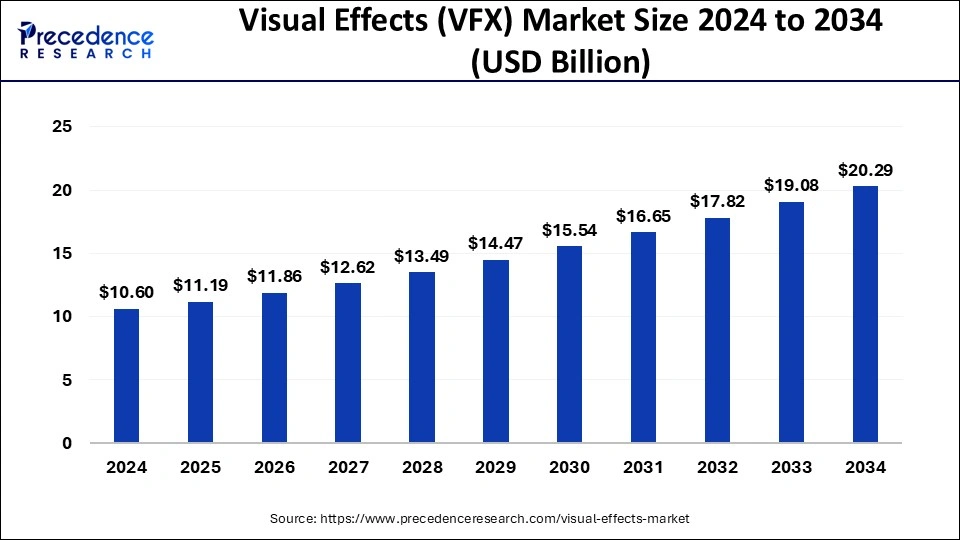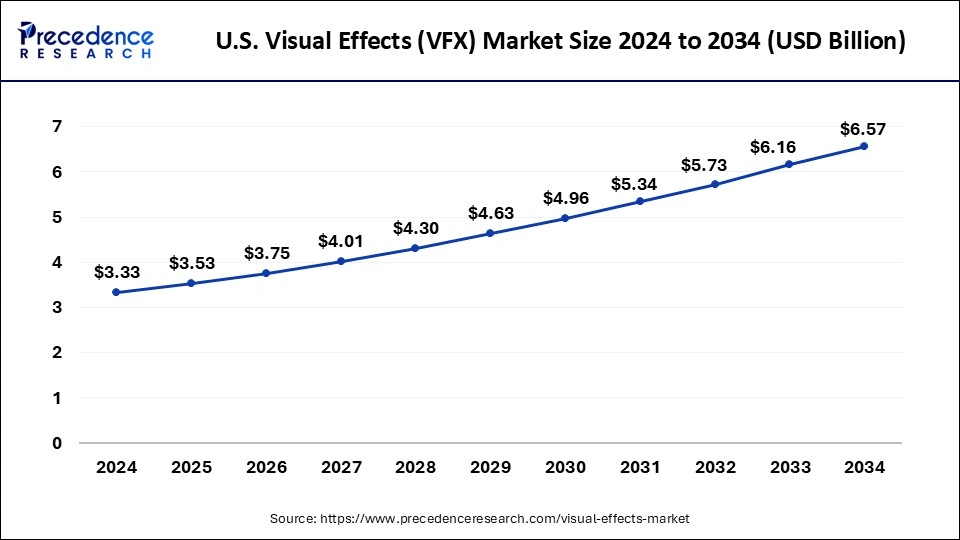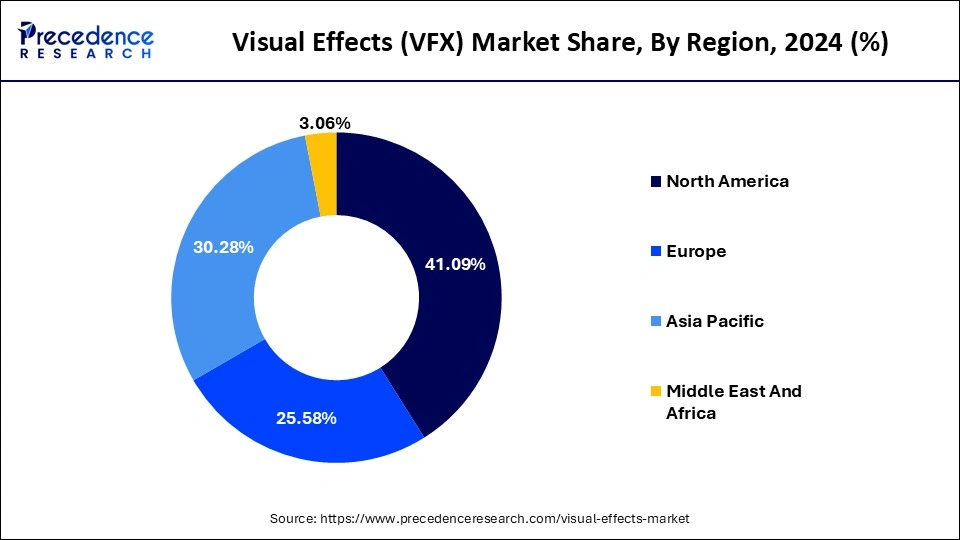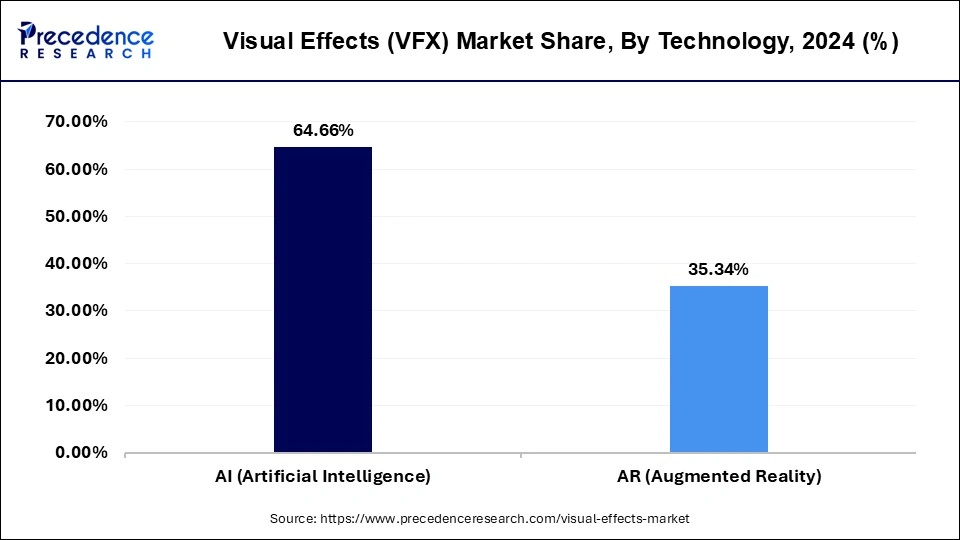Visual Effects (VFX) Market Size and Forecast 2025 to 2034
The global visual effects (VFX) market size was USD 10.60 billion in 2024, estimated at USD 11.19 billion in 2025 and is anticipated to reach around USD 20.29 billion by 2034, expanding at a CAGR of 6.83% from 2025 to 2034. High-quality visual effects are in greater demand in several industries, including virtual reality (VR), gaming, advertising, cinema, and television. As these businesses grow and change, there is an increasing demand for visually beautiful material.

Visual Effects (VFX) Market Key Takeaway
- The global visual effects (VFX) market was valued at USD 10.60 billion in 2024.
- It is projected to reach USD 20.29 billion by 2034.
- The visual effects (VFX) market is expected to grow at a CAGR of 6.83% from 2025 to 2034.
- North America dominated the global market with the largest market share of 41.09% in 2024
- Asia Pacific is expected to fastest CAGR of 7.01% during the forecast period.
- By component, the software segment contributed the highest market share of 59.52% in 2024.
- By component, the service segment is projected to grow substantially during the forecast period.
- By product, the animation segment captured the biggest market share of 34.71% in 2024.
- By product, the animation is predicted to grow rapidly during the forecast period.
- By technology, the AI (artificial intelligence) segment generated a major market share of 64.66% in 2024.
- By technology, the AR (augmented reality) segment is expected to gain a significant share during the forecast period.
- By application, the movie segment has held the largest market share of 37.43% in 2024.
- By application, the gaming segment is projected to rise at a substantial CAGR during the forecast period.
U.S. Visual Effects (VFX) Market Size and Growth 2025 to 2034
The U.S. visual effects (VFX) market size reached USD 3.33 billion in 2024 and is expected to be worth around USD 6.57 billion by 2034, growing at a CAGR of 7.16% from 2025 to 2034.

North America held the largest market share in 2024 and is expected to grow further during the forecast period. The center of the world's film business has long been thought to be North America, especially Los Angeles. Hollywood studios drive a large percentage of the demand for VFX services. Leading the way in industry technological developments are VFX studios in North America. To expand the possibilities for visual effects, they consistently spend money on research and development.
The film business mostly drives the visual effects (VFX) market in North America, but other industries like gaming, advertising, virtual reality (VR), and augmented reality are also becoming more and more interested in purchasing VFX. (AR). This demand diversification enhances the durability of the VFX market in North America.

Europe is expected to grow substantially in the upcoming years. Over the past ten years, the demand for high-quality content in the film, television, advertising, and gaming industries has grown steadily in Europe, driven by a number of factors, including technological advancements, the availability of skilled VFX professionals in the area, and increased demand for high-quality content.
The visual effects (VFX) market in Europe is quite competitive, with a wide range of businesses providing services in different industries. These businesses offer a broad range of services, such as motion capture, virtual reality (VR), augmented reality (AR), 2D and 3D animation, and computer-generated imagery (CGI). Furthermore, the European game developers' increasingly complex use of visual effects in their games has been a major factor in the expansion of the visual effects business.
Market Overview
Over the past few years, the demand for high-quality visual effects (VFX) in movies, TV shows, commercials, video games, and virtual reality (VR) content has been driving the expansion of the global VFX industry. As per many sources, the visual effects (VFX) market is estimated to be worth several billion dollars and is anticipated to rise at a robust pace in the future. Technological developments, especially in computer graphics, rendering, and animation software, have been a major factor in the VFX industry's expansion. The advancement of more potent hardware, like GPUs (Graphics Processing Units), has also made it possible for VFX artists to produce more intricate and realistic visual effects.
The visual effects (VFX) market is being shaped by a number of new developments, such as the increasing application of augmented reality (AR), real-time rendering, and virtual production approaches. The VFX sector is growing, but it still has to contend with issues, including tight production timetables, cost pressures, and competition from emerging markets. The COVID-19 epidemic also caused scheduling and process disruptions, necessitating VFX studios to adjust to remote work settings. Although Hollywood continues to be a key hub for visual effects production, other areas, like Canada, the UK, Australia, and New Zealand, have become significant VFX hubs because of favorable government regulations, talented labor pools, and tax incentives.
Visual Effects (VFX) Market Growth Factors
- The need for superior visual effects in motion pictures, television series, and video games is always increasing. Global entertainment industry expansion has led to a similar rise in the demand for visually attractive effects to draw in viewers and set content apart.
- Technological developments have enabled VFX artists to produce effects that are more realistic and immersive, especially in the areas of computer graphics, rendering, and animation software. Real-time rendering engines and cloud-based rendering services are examples of innovations that have sped up production and reduced the cost of visual effects.
- The popularity of streaming services like Netflix, Disney+, and Amazon Prime Video has increased consumer demand for well-produced original content. In an effort to draw users and rival traditional studios, these platforms are making significant investments in VFX-driven productions.
- Visual effects are no longer just used in the entertainment sector. It's being used more and more in industries including simulation, virtual reality (VR), augmented reality (AR), architecture, and automobile design. The visual effects (VFX) market is expanding due to this application diversification, which is also generating new revenue streams.
- The outsourcing of visual effects work to nations with cheaper labor costs, such as South Korea, China, and India, has increased as a result of the globalization of the film and television industries. This tendency has given studios all over the world the chance to expand in the global visual effects (VFX) market.
Market Scope
| Report Coverage | Details |
| Global Market Size in 2024 | USD 10.60 Billion |
| Global Market Size in 2025 | USD 11.19 Billion |
| Global Market Size by 2034 | USD 20.29 Billion |
| Market Growth Rate from 2025 to 2034 | CAGR of 6.83% |
| Largest Market | North America |
| Base Year | 2024 |
| Forecast Period | 2025 to 2034 |
| Segments Covered | By Component, By Product, By Technology, and By Application |
| Regions Covered | North America, Europe, Asia-Pacific, Latin America, and Middle East & Africa |
Market Dynamics
Driver
Growing popularity of streaming platforms
In an effort to draw in new users, streaming services like Netflix, Amazon Prime Video, and Disney+ are always growing their catalogs. As a result, there is a growing need for high-caliber media, such as TV series and films, which frequently need substantial visual effects to improve their narrative and aesthetics. Because there is a global audience for streaming services, content providers are seeking to appeal to a wider range of consumers worldwide. When it comes to producing immersive experiences that appeal to viewers of all languages and cultures, visual effects are essential. To meet the expectations of streaming platforms for high-quality video, The visual effects (VFX) market is always inventing and pushing the frontiers of technology.
Restraint
Intellectual property concerns
In the visual effects (VFX) market, copyright law protects visual effects inventions, including digital characters, environments, and effects sequences. This shields the original authors' work from unlawful use, dissemination, or public exhibition. Numerous visual effects studios create exclusive methods, procedures, and equipment to accomplish particular visual effects. These trade secrets are precious resources that are safeguarded by various legal protections such as nondisclosure agreements (NDAs). VFX firms occasionally license intellectual property to other artists or businesses for use in their productions. This could be everything from 3D models or character designs to stock video and music.
Opportunity
Architectural visualization
To aid customers and stakeholders in understanding the proposed design, architects and designers frequently produce intricate visualizations prior to the start of actual building construction or any other type of architectural project. Superior renderings and virtual tours present the proposed homes in a realistic and eye-catching way, which can assist developers in drawing in investors or buyers. Proficiency in producing realistic architecture visualizations can be highly valued in the visual effects industry for use in advertising campaigns and collateral. Architectural visualization is used by government organizations and urban planners to show suggested infrastructure projects, city planning, and urban development strategies. Planners are able to evaluate the possible effects of new construction on the surrounding communities and environment by developing intricate 3D models and simulations.
Component Insights
The software segment holds the dominant share of the global market. The visual effects (VFX) market has a varied software environment that is always changing to satisfy industry demands. Highly regarded as one of the renderings, animation, and 3D modeling industry standards. It is widely utilized in the creation of video games, television shows, and movies. An additional well-liked option for 3D modeling, animation, and rendering, especially in the fields of movies, video games, and architectural visualization. Houdini is used for modeling, rigging, animation, particle effects, and more. It is well-known for its procedural approach to VFX. It's especially well-liked for dynamic effects and simulations.
The service segment is projected to grow substantially during the forecast period. The visual effects (VFX) market has a varied software environment that is always changing to satisfy industry demands. Highly regarded as one of the renderings, animation, and 3D modeling industry standards. It is widely utilized in the creation of video games, television shows, and movies. An additional well-liked option for 3D modeling, animation, and rendering, especially in the fields of movies, video games, and architectural visualization. Houdini is used for modeling, rigging, animation, particle effects, and more. It is well-known for its procedural approach to VFX. It's especially well-liked for dynamic effects and simulations. ZBrush is a program that was created specifically for digital painting and sculpting. It is widely used to create extremely realistic 3D models, especially of animals and figures.
Visual Effects (VFX) Market Revenue, By Component 2022-2024 (USD Million)
| Component | 2022 | 2023 | 2024 |
| Software | 5,681.10 | 5,978.84 | 6,310.15 |
| Service | 3,908.10 | 4,089.82 | 4,292.15 |
Product Insight
The simulation FX segment led the market in 2024. A vital part of the visual effects (VFX) market is simulation FX or effects simulation. It entails modeling a variety of events realistically, including fire, smoke, water, explosions, and fabric dynamics. These simulations are often utilized to improve realism and provide spectators with immersive experiences in movies, TV series, video games, and other media. With the rise in popularity of real-time simulation technologies, visual effects artists may now see immediate feedback and make changes as needed. In addition to being utilized for game development, real-time engines such as Unreal Engine and Unity are also used for pre-visualization and even final rendering of visual effects scenes.
The animation is predicted to grow rapidly during the forecast period. In the dynamic and ever-evolving visual effects (VFX) market, animation is a vital component of many different sectors, including advertising, gaming, film, and television. Innovations in technology keep expanding the realm of animation and visual effects. Animations are becoming more realistic and high-quality thanks to tools like motion capture, virtual reality (VR) technology, and sophisticated rendering software. Emerging markets are starting to make a big difference in the animation and visual effects industries, especially in Asia and Latin America. The animation industries of nations like South Korea, China, and India are expanding, and these nations are creating content for both local and global audiences.
Visual Effects (VFX) Market Revenue, By Product2022-2024 (USD Million)
| Product | 2022 | 2023 | 2024 |
| Animation | 3,309.35 | 3,484.96 | 3,680.32 |
| Compositing | 2,205.63 | 2,319.60 | 2,446.40 |
| Simulation FX | 2,021.23 | 2,124.88 | 2,240.24 |
| Modeling | 1,246.04 | 1,307.26 | 1,375.39 |
| Matte Painting | 806.96 | 831.96 | 859.95 |
Technology Insights
The Artificial Intelligence (AI) segment led the market in 2024. Routine and time-consuming VFX pipeline operations like tracking, matte painting, and rotoscoping can be automated with AI. This enables artists in the visual effects (VFX) market to concentrate more on the artistic elements of their creations. More realistic depiction of VFX elements, including textures, lighting, and simulations, is made possible by AI approaches like machine learning and neural networks. This makes the visual effects in movies, TV series, and video games more realistic and engaging. Many visual effects jobs, including noise reduction, image restoration, and inpainting, are being tackled with deep learning algorithms. These methods can shorten the post-production turnaround time while also increasing the quality of VFX shots.

The AR (augmented reality) segment is expected to gain a significant share during the forecast period. In the visual effects (VFX) market, augmented reality (AR) has been making major progress, providing a variety of creative opportunities for filmmakers, advertisers, and content producers. By superimposing real-time digital content over the real world, augmented reality (AR) allows for interactive experiences. Marketing campaigns can benefit from this interaction, which enables customers to interact with goods or personalities in novel ways. Through the exploration of non-traditional storytelling strategies and visual aesthetics, augmented reality opens up new creative opportunities for filmmakers and VFX artists. AR allows designers to explore the limits of their imagination by enabling them to create fanciful animals and futuristic worlds.
Visual Effects (VFX) Market Revenue, By Technology 2022-2024 (USD Million)
| Technology | 2022 | 2023 | 2024 |
| AI (Artificial Intelligence) | 6,159.68 | 6,488.90 | 6,855.21 |
| AR (Augmented Reality) | 3,429.52 | 3,579.76 | 3,747.09 |
Application Insights
The movie segment holds the largest share of the market globally. The visual effects (VFX) market in film is always changing as a result of technological breakthroughs that push limits and give viewers ever-more immersive experiences. "Interstellar," another film by Christopher Nolan, depicted space travel and unusual celestial phenomena by fusing real-world effects with state-of-the-art computer graphics. The film's visual effects, which featured representations of far-off planets and black holes, were praised for their astounding realism and scientific correctness.
The gaming segment is projected to rise at a substantial CAGR during the forecast period. Modern technology is essential to both sectors. VFX pipelines frequently incorporate gaming-developed techniques like motion capture and real-time rendering, which improve process efficiency and yield higher-quality results. Advancements in the visual effects (VFX) market are driven by the growing expectation of gamers for high degrees of realism in their gaming experiences. In response, VFX companies push the envelope of what's feasible to live up to these expectations, creating a positive feedback loop of innovation. The need for VFX services has grown as a result of gaming's rising popularity, especially in fields like virtual production and augmented reality. In order to meet the needs of this growing market, VFX businesses are diversifying their offers more and more.
Visual Effects (VFX) Market Revenue, By Application2022-2024 (USD Million)
| Application | 2022 | 2023 | 2024 |
| Movies | 3,574.48 | 3,761.21 | 3,968.96 |
| Television | 2,409.31 | 2,533.83 | 2,672.41 |
| Gaming | 2,078.02 | 2,185.68 | 2,305.46 |
| Advertisements | 993.94 | 1,043.33 | 1,098.30 |
| Others | 533.45 | 544.62 | 557.17 |
Visual Effects (VFX) Market Companies
- Framestore Ltd.
- Hydraulx VFX Ltd
- Ingenuity Studios Inc.
- Makuta Effects Pvt. Ltd.
- Milk VFX, Rodeo FX Inc.
- Scanline VFX
- Sony Group Corp.
- Spin VFX
- Technicolor SA
- The Walt Disney Co.
- Tippett Studio Inc.
- Weta Digital Ltd.
Recent Developments
- In October 2023, A group of visual effects companies, associations, and experts created a brand-new yearly occasion called World VFX Day. The worldwide celebration, which is set to begin on December 8, is to raise awareness of the visual effects sector, which helps filmmakers bring stories to life that are otherwise unimaginable.
- In March 2024, with expertise in providing visual effects for a wide range of projects, Digikore Studios Limited (NSE – DIGIKORE) announced its upcoming launch of the world's first cloud-based marketplace of virtual production sets.
Segment Covered in the Report
By Component
- Software
- Service
- Hardware
By Product
- Simulation FX
- Animation
- Modelling
- Matte painting
- Compositing
By Technology
- AI (artificial intelligence)
- AR (augmented reality)
By Application
- Movies
- Television
- Gaming
- Advertisements
- Others
By Geography
- North America
- Asia Pacific
- Europe
- Latin America
- Middle East & Africa
For inquiries regarding discounts, bulk purchases, or customization requests, please contact us at sales@precedenceresearch.com
Frequently Asked Questions
Ask For Sample
No cookie-cutter, only authentic analysis – take the 1st step to become a Precedence Research client
 sales@precedenceresearch.com
sales@precedenceresearch.com
 +1 804-441-9344
+1 804-441-9344